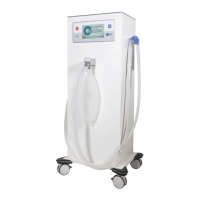– 24 –
Pay particular
attention to
Countermeasure
Leaks at the mask Annual maintenance and inspection
For each patient: Check whether the mask is tting well to the skin and is the right
size and model. Watch out for open areas when it is put on.
Use double masks in particular, which have come out top in studies. Double masks
minimise ambient air contamination (as per studies of the University of Bonn and
many others).
Switch on the suction unit before the nitrous oxide starts owing and check it
using the vacuum control block.
Leaks at the pressure reduc-
ers/pressure hoses
Annual maintenance and inspection
O-rings seal the pressure reducers and pressure hoses. If there is hissing at the pres-
sure reducer or hose, the O-rings must be checked and may have to be replaced.
Spray leak detection spray on all screw joints and connections on the mixer and
pressure reducers. The leak detection spray consists of soap and water, and bubbles
form quickly at the site of any leak. This test must be performed every time a cylin-
der is changed, and at least monthly.
Close the gas cylinders completely; there should be no appreciable drop in pressure
for an hour.
Always open the high-pressure valves of the gas cylinder s slowly. Opening them
quickly can cause the pressure reducers to malfunction.
Leak at the bag Annual maintenance and inspection
Weekly: quick check for leaks (refer to Regular checks)
Too much nitrous oxide
in the treatment room
Breathing bag too full. Reduce the total ow. Always watch for vertical folds in the
breathing bag.
Do not sedate with nitrous oxide in any one room for longer than two hours with-
out a break.
Ventilate the room (for at least 5 minutes) after each patient.
Switch on the air conditioning to circulate the air in the room.
Patient speaking too much/
breathing through his
mouth
Tell the patient to breathe through his nose and only speak if necessary.
Discontinue nitrous oxide treatment with patients who cannot breathe deliberately
through the nose (small children, etc.).
Each practice should create an individual risk analysis as per the table above.

